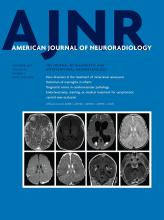We appreciate the comments by Dr Zhang and colleagues on “Brain Perfusion Alterations on 3D Pseudocontinuous Arterial Spin-Labeling MR Imaging in Patients with Autoimmune Encephalitis: A Case Series and Literature Review” and thank the Editor for giving us the opportunity to reply to the comments. The application of arterial spin-labeling (ASL) for the assessment of autoimmune encephalitis (AE), a heterogeneous group of newly identified disorders, has seldom been described previously, and we agree that AE may have different abnormal perfusion patterns on 3D pseudocontinuous arterial spin-labeling (pCASL).
First, the authors mentioned the proportion of hyperperfusion alterations on ASL in their hospitalized patients with AE, which may be related to the types of AE included. AE subtypes that predominantly involve the white matter are less likely to cause hyperperfusion compared with autoimmune limbic encephalitis. In our study, the cases mainly included autoimmune limbic encephalitis and anti-N-methyl-D-aspartate receptor (NMDAR) encephalitis, not, as the author mentioned in the letter, AE subtypes that predominantly involve the white matter, such as anti-myelin oligodendrocyte glycoprotein antibody-associated encephalitis and Hashimoto encephalopathy, and usually present with a clinical profile and MR imaging features clearly different from those of autoimmune limbic encephalitis.1
Second, 2 main abnormal metabolic patterns (mixed hyper-/hypometabolic and neurodegenerative-like) on PET/CT have been reported,2 and different “paradigms” of encephalitis (mainly limbic versus NMDAR) may have different PET/CT findings.3 Studies have shown that metabolic patterns on PET/CT, to a certain extent, are associated with different autoantibody subtypes,4 implying that different pathophysiologic mechanisms may exist. We admit that the brain perfusion patterns may be associated with different autoantibody subtypes, which is an impetus for further studies revealing the correlation between perfusion and metabolism in AE subtypes.
Third, perfusion alterations for AE are also linked to the staging of disease, which usually presents with hyperperfusion during the acute and subacute periods and hypoperfusion in the chronic phase, though the division of the staging is controversial in clinical practice. Meanwhile, treatment may also affect the perfusion changes.5,6
Finally, the authors mentioned the mechanisms leading to the perfusion alteration for AE. The exact pathophysiologic mechanism remains to be elucidated, and possible reasons include an inflammatory process due to an antigen-antibody-mediated immune response and the loss of vascular autoregulatory mechanisms due to autonomic instability, and so forth. In addition, many subtypes of AE are frequently accompanied by seizures, which can also affect CBF. In our study, the patients who had clinical seizures were imaged during the interictal phase, but this effect cannot be completely excluded theoretically.
In summary, we admit that the sample size was small and the type of patients with AE was limited in our study. However, we believe that 3D pCASL may have added value in the early diagnosis and assessment of therapeutic effects in AE. Because perfusion alterations may be associated with multiple factors, such as autoantibody subtypes, the staging of disease, and whether the disease is accompanied by seizures, large cohort and longitudinal studies are needed to elucidate the contribution of 3D pCASL in the scenarios discussed above.
References
- © 2022 by American Journal of Neuroradiology












